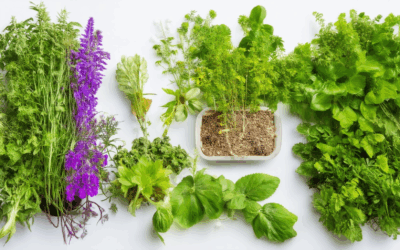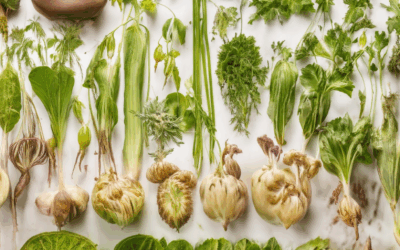Organic gardening offers a sustainable and healthy alternative to traditional farming methods, providing a rewarding experience for both novice and experienced growers. By adopting organic garden practices, you can cultivate thriving plants while promoting environmental sustainability and protecting your crops from harmful chemicals. This comprehensive guide explores the essential principles and techniques that will help you master organic garden practices, ensuring your natural garden thrives year after year. From understanding the basics of organic gardening to discovering effective strategies for soil preparation and pest control, this article provides practical insights and expert tips to help you get started. Whether you’re looking to improve your garden’s productivity or simply reduce your environmental footprint, organic gardening is a beneficial and rewarding endeavor. Join us as we dive into the world of organic gardening, uncovering the secrets to successful growth and the importance of maintaining healthy soil and plants. With the right knowledge and dedication, anyone can learn how to grow an organic garden and enjoy the freshest, most nutritious produce possible.
Key Takeaways
– Choose the Right Location: Select a sunny, well-drained spot in your yard for your organic garden.
– Prepare the Soil: Test and adjust your soil’s pH (6.0–8.0) with organic amendments like compost or lime.
– Select the Right Plants: Start with easy-to-grow veggies like tomatoes and herbs, plus flowers for pollinators.
– Water Efficiently: Use drip irrigation and mulch to conserve moisture and suppress weeds.
– Organic Fertilization: Use compost, fish emulsion, or worm castings for nutrient-rich growth.
– Manage Pests Naturally: Employ row covers and ladybugs to control pests organically.
– Maintain Regularly: Weed, water, and monitor plants daily for health and productivity.
– Plan Seasonally: Grow crops suited to your climate and rotate them to maintain soil health.
– Compost Effectively: Create a compost pile to recycle waste and enrich your soil.
– Stay Educated: Reference gardening guides and join clubs for expert advice and tips.
– Harvest and Preserve: Enjoy fresh produce by canning, freezing, or fermenting.
– Design a Thoughtful Layout: Zone your garden into beds, pollinator areas, containers, and ornamentals.
– Space Plants Smartly: Follow planting guidelines and practice companion planting for better growth.
– Use Support Systems: Install stakes or trellises for vertical gardening and airflow.
– Understand Healthy Soil: Mix topsoil, compost, and amendments for nutrient-rich, structured soil.
These takeaways provide a roadmap for creating a thriving organic garden, from site selection to soil preparation and ongoing maintenance.
Rules for Organic Gardening
Organic gardening is a sustainable approach to cultivating plants and crops that avoids the use of synthetic chemicals like pesticides, herbicides, and artificial fertilizers. To practice organic gardening effectively, consider the following principles:
Key Principles of Organic Gardening
- Composting:** Regularly use compost made from kitchen scraps, manure, or leaves to enrich the soil. Compost improves soil structure, retains moisture, and promotes microbial activity.
- Avoid Synthetic Chemicals:** Refrain from using conventional pesticides, herbicides, and chemical fertilizers. Opt for natural alternatives like neem oil, insecticidal soap, and compost.
- Crop Rotation:** Rotate crops to maintain soil health and prevent pests and diseases. Common rotations include vegetables with legumes, root crops, and fruit-bearing plants.
- Biodiversity:** Plant a variety of species to attract beneficial insects, birds, and pollinators. This creates a balanced ecosystem that discourages pests and diseases.
Practices to Enhance Organic Gardening Success
- Choose Non-GMO Seeds and Plants:** Ensure seeds and plants are free from genetically modified organisms to maintain control over your growing process.
- Mulch Appropriately:** Apply mulch around plants to retain moisture, suppress weeds, and regulate soil temperature.
- Practice Companion Planting:** Pair plants that benefit each other, such as marigolds (which repel pests) with tomatoes.
- Use Natural Fertilizers:** Opt for organic fertilizers like fish emulsion, seaweed, or worm castings to provide essential nutrients without harmful chemicals.
- Implement Vertical Gardening:** Save space and extend the growing season by using structures like trellises, cages, or vertical planters.
Benefits of Organic Gardening
- Improves soil health and sustainability.
- Reduces exposure to harmful chemicals and toxins.
- Yields healthier, tastier, and more nutritious crops.
- Contributes to environmental conservation and biodiversity.
For more resources and detailed guides on organic gardening techniques, visit OldSeed.org .
Disadvantages of Organic Gardening
While organic gardening offers numerous benefits, it also presents several drawbacks worth considering:
- Lower Yields:** One of the most common disadvantages is that organic gardens often yield fewer crops compared to conventional farms. This is due to the absence of synthetic fertilizers and pesticides, which can lead to weaker plant resistance and reduced productivity.
- Labor-Intensive:** Organic gardening requires more manual labor, such as composting, mulching, and hand-picking pests. This can be time-consuming, especially for larger gardens or those with limited resources.
- Limited Availability of Certain Crops:** Some crops, like genetically modified organisms (GMOs), are less commonly available in organic versions. This can limit diversity in gardens and affect crop yields.
- Potential for Lower Profitability:** For commercial farmers, organic certification can increase costs and reduce profit margins. However, for home gardeners, the benefits often outweigh these challenges.
Despite these drawbacks, many gardeners find the health and environmental benefits of organic gardening to be well worth the effort. By adopting sustainable practices and understanding the unique challenges, you can enjoy a thriving organic garden that contributes positively to your local ecosystem.
For more tips and resources on overcoming these challenges, visit our gardening resources page or explore our comprehensive organic gardening guide .
What is an organic garden approach?
An organic garden approach refers to a sustainable and environmentally friendly method of gardening that focuses on natural processes and avoids synthetic chemicals. This approach emphasizes the health of the soil, biodiversity, and the use of natural pest control methods to grow plants in harmony with nature.
Here are the key principles of an organic garden approach:
- Soil Health : Organic gardening prioritizes soil health by avoiding synthetic fertilizers and pesticides. Healthy soil is essential for strong plant growth and supports beneficial microorganisms.
- Biodiversity : Organic gardens often include a variety of plants to create habitats for pollinators, birds, and beneficial insects, which help control pests naturally.
- Natural Pest Control : Instead of chemical pesticides, organic gardeners use methods like companion planting, crop rotation, and biological controls to manage pests.
- Composting : Recycling kitchen scraps and yard waste into compost enriches the soil and reduces the need for external inputs.
- Harmony with Nature : The organic approach works in sync with natural cycles, considering seasonal planting and the balance of ecosystems.
By adopting these practices, organic gardening promotes environmental sustainability and produces healthier crops for both people and the planet.
How to Start an Organic Garden for Beginners
Starting an organic garden can be a rewarding experience, but it requires careful planning and preparation. Here’s a step-by-step guide to help you get started:
1. Choose the Right Location
- Select a spot in your yard that receives full sun, has easy access to water, and good drainage.
- Avoid areas prone to strong winds, as this can damage plants.
- South-facing gardens tend to receive more sunlight, which is ideal for many crops.
2. Prepare the Soil
- Test your soil’s pH level using a simple test kit. Most vegetables thrive in a pH range of 6.0 to 8.0.
- If your soil needs adjustment, mix in organic matter like compost or lime to achieve the desired pH level.
- Clear the area of weeds, rocks, and debris before planting.
3. Select Plants and Seeds
- Choose easy-to-grow vegetables like tomatoes, peppers, zucchini, and cucumbers.
- Herbs such as basil, parsley, and cilantro are great starters.
- Consider adding flowers like marigolds or calendula to attract pollinators and improve soil health.
4. Watering Techniques
- Install a drip irrigation system to efficiently water your plants.
- Mulch around plants to conserve moisture and suppress weeds.
5. Fertilization
- Use organic fertilizers like compost, fish emulsion, or worm castings.
- Apply fertilizers according to the specific needs of your plants.
6. Pest and Disease Control
- Use physical barriers like row covers to protect plants from pests and frost.
- Encourage natural predators like ladybugs and birds to control pests.
7. Weeding and Maintenance
- Weed regularly to keep your garden productive and neat.
- Use tools like gloves and hoes to manage weeds effectively.
8. Seasonal Planning
- Plant seeds or seedlings suited to your growing season and climate zone.
- Rotate crops to maintain soil health and reduce disease risks.
- Space plants appropriately to allow for healthy root development and airflow.
9. Composting
- Set up a compost pile or bin to recycle kitchen scraps and yard waste.
- Turn the compost regularly to aerate it and speed up decomposition.
10. Stay Informed
- Refer to gardening books, online guides, or join a local gardening club for support and advice.
- Learn about sustainable practices and organic gardening techniques to improve your skills over time.
11. Be Patient and Monitor
- Understand that gardening takes time, and not all plants grow at the same rate.
- Inspect your plants daily to monitor for signs of pests, diseases, or nutrient deficiencies.
12. Harvest and Enjoy
- Harvest your crops when they reach maturity, typically according to the variety’s specific instructions.
- Preserve your harvest by canning, freezing, or fermenting for year-round enjoyment.
By following these steps and staying committed, you’ll be well on your way to successfully growing your own organic garden. For more detailed guides and tools, visit OldSeed’s Gardening Guides .
Creating a Thoughtful Garden Layout for Beginners
Designing a garden that works well for you and your plants requires careful planning. Here’s a step-by-step guide to crafting a functional and visually appealing garden layout:
Section 1: Define Your Space
- Assess Your Location: Consider sunlight exposure, soil type, and water access. Most vegetables thrive in full sun, while some thrive in partial shade.
- Choose a Layout Shape: Opt for rectangular beds for ease of maintenance or curved designs for a decorative touch.
- Plan for Accessibility: Make sure pathways are wide enough for wheelbarrows and easy to navigate.
Section 2: Zoning Your Garden
- Vegetable Beds: Allocate a dedicated area for edible plants. Divide this zone into rows or columns based on the height of the plants. Tall crops like tomatoes and peppers can go at the back, while shorter varieties like lettuce and radishes can be up front.
- Pollinator Attractors: Include flowers like marigolds, calendula, and lavender to draw beneficial insects and bees. These can be placed along borders or in a separate pollinator garden.
- Container Gardens: Reserve small spaces for herbs, container vegetables, or ornamental plants. Containers are great for seasoning and allow for mobility.
- Ornamental Features: Add a focal point like a birdhouse, statue, or water feature to enhance visual appeal and create a welcoming environment.
Section 3: Plant Selection and Spacing
- Start Small: Begin with a few key plants to avoid overwhelming yourself. Choose varieties suited to your climate and growing season.
- Space Efficiently: Plant seeds or seedlings according to the recommended spacing on the product labels. Overcrowding leads to poor growth and disease.
- Consider Companion Planting: Some plants repel pests or improve soil health. For example, basil attracts aphids but can be grown alongside tomatoes to keep them healthy.
Section 4: Maintenance and Watering
- Regular Weeding: Keep beds tidy to prevent weeds from competing with your plants.
- Water Wisely: Use mulch to retain moisture and reduce watering frequency. Water deeply but less often to encourage root growth.
- Support Systems: Use stakes, cages, or trellises to help plants like beans and tomatoes grow vertically, saving space and preventing overcrowding.
Section 5: Seasonal Rotation
- Rotate Crops: Change plant locations each season to protect against pests and diseases that overwinter in certain spots.
- Succession Planting: Replace harvested crops with fast-growing plants like lettuce or radishes to maximize space and continuous harvests.
By following these guidelines, you’ll create a productive and beautiful garden that caters to both your needs and your plants. Experiment with different layouts and plant combinations to find what works best for your space and lifestyle.
For more tips on gardening techniques and plant selection, explore our comprehensive resource library.
What is the Best Soil for Organic Gardening?
Organic gardening thrives on healthy, nutrient-rich soil, which promotes robust plant growth and sustainability. The ideal soil for organic gardening typically consists of a balanced blend of organic matter to enhance fertility, structure, and microbial activity.
Key Components of Organic Soil
- Topsoil: A high-quality topsoil forms the base, providing essential nutrients like nitrogen, phosphorus, and potassium. Look for organic topsoil derived from composted materials.
- Compost: Incorporate aged compost (at least 6 months) to boost soil organic matter and microbial life. Compost improves water infiltration and root development.
- Other Organic Materials: Add ingredients like shredded leaves, worm castings, wood-based fire ash, and completely composted manure to diversify nutrients and improve soil structure.
Considerations for Mixing
For optimal results, aim for a mix of approximately 50% topsoil, 30% compost, and 20% organic amendments. Adjust based on your specific soil type and garden goals.
Suggested Organic Soil Ingredients
- Old Seed’s Comprehensive Soil Guide offers detailed recommendations for mixing and preparing your soil.
- Shredded leaves act as a natural mulch and carbon source, while worm castings provide concentrated nutrients and beneficial earthworms.
- Mineralized soil and wood-based fire ash can help adjust pH levels and provide calcium, magnesium, and potassium.
Conclusion
By using a well-balanced mix of topsoil, compost, and organic amendments, you can create fertile soil that supports thriving plants and a healthy garden ecosystem. For further insights and tailored advice, visit our organic gardening resources .








0 Comments